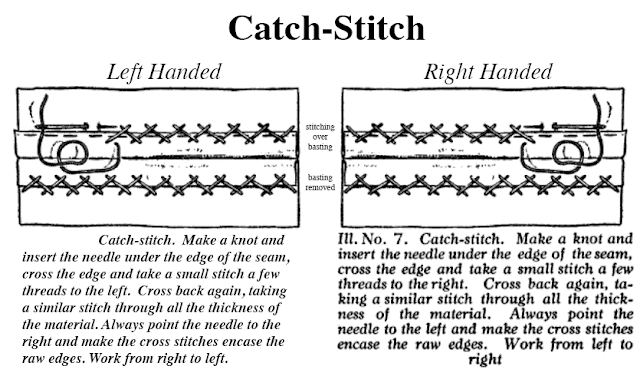Introduction
For this series I am going through an old sewing book and experimenting with the projects within it. The book is called "
The Sewing Book, Containing Complete Instructions in Sewing and Simple Garment-making for Children in Primary and Grammar Grades," Edited by Anne L. Jessup, Published by the Butterick Publishing Company, New York NY, 1913. The book is out of copyright (and free to all). It has been scanned as part of the Google Books effort and is available in various formats, visit
https://books.google.com/books/about/The_Sewing_Book.html?id=b7wwAQAAMAAJ
Catch-stitched Patch
[Practice] Supplies
Flannel, either striped or plain, 5 by 5 inches, and 3 by 3 inches; Cotton, no. 60 or sewing silk the color of the flannel; Needle, No. 8, etc.
[Instructions]
This patch is suitable for underwear. Cut away the torn part, forming a square hole. Baste the patch under the hole, matching the warp and woof lines. Catch-stitch on the right side, taking the lower stitches just below the edge, the upper ones about a quarter of an inch above the edge. Turn to the wrong side and catch-stitch the patch to the garment. The edge of the patch should not extend more than three-quarters of an inch on the wrong side around the square.
Note
The single edges are used in this patch to avoid the thickness of folded edges of material of this kind. The stitches should be small and very even, one being taken diagonally in each corner.
My Practice Patch
My Comments
We may be most familiar with flannel as cotton "flannelette," in things
like winter pajamas and plaid shirts.
Wool flannel is still available today. See some flannel underwear here.
When I made this sample patch, I had no wool flannel scraps. I used some cotton flannelette. Obviously the black/blue side is the right side and the white side is the wrong side. As you can see my hand stitches are uneven. For that reason I would only do this kind of patch on a solid fabric where the stitching would be less visible on the front. If your stitches are even, then that wouldn't be a problem. The front stitching (first in instructions) was easy to execute. The stitching on the back seemed just as easy but after refreshing my memory on the catch-stitch, it turns out I should have taken the lower part of the stitch through both layers of fabric. That would add some more stability. These stitches are barely visible on the front, which is nice.
I would recommend this type of patch if you know the fabric won't show (e.g. underwear is covered up), won't fray (or won't be washed or hard-worn), if it is dyed through (not a print like the flannelette I used as the white shows in little bits on the front), and if the fabric is too thick or uncooperative for other types of patches.
This patch is designed for be made with hand stitching (but it's only one kind of stitch, which is nice and easy). To machine stitch this patch perhaps a zig-zag or better yet three-step zig-zag would work. However these stitches will show more, by which I mean the second line of stitching that is worked from the wrong side will be just as visible on the front as the first right-side stitches. Other patches are better suited to machine stitching.
The Catch-Stitch
Because I'm so nice, I'm also providing the catch-stitch instructions from the book with added left handed instructions because duh.





















